I got the regular mailout from Glenn as part of my nascent involvement in IslandHF. Glenn made mention of the fact that it’s homebrew month, and was polling for interest in writing about projects we have been working on. Ever since I got my FX4-CR I’ve been slapping stuff together at a high rate of speed – let me bring you up to date on what’s been happening.
Vertical Dipole for 10m
I had to get started somewhere. I do analysis paralysis particularly well, so I settled on the band that had the best bang for buck in terms of raw materials required. Considering that I’d be looking initially at half-wave antennas, I figured 10m was my best go while I get my setup(s) figured out. I found a YouTube Video from Ham Radio DX that seemed to fit the bill right away. I fetched some wire and coax from Paul (VA7EWT) down at Queale, and off I went.
The first iteration was a 10m vertical dipole. Seemed dead simple – a length of wire soldered to the centre connector of some coax, go down said length of coax a particular distance, wind an ugly choke, throw a connector on it, and kablam, easy peasy.
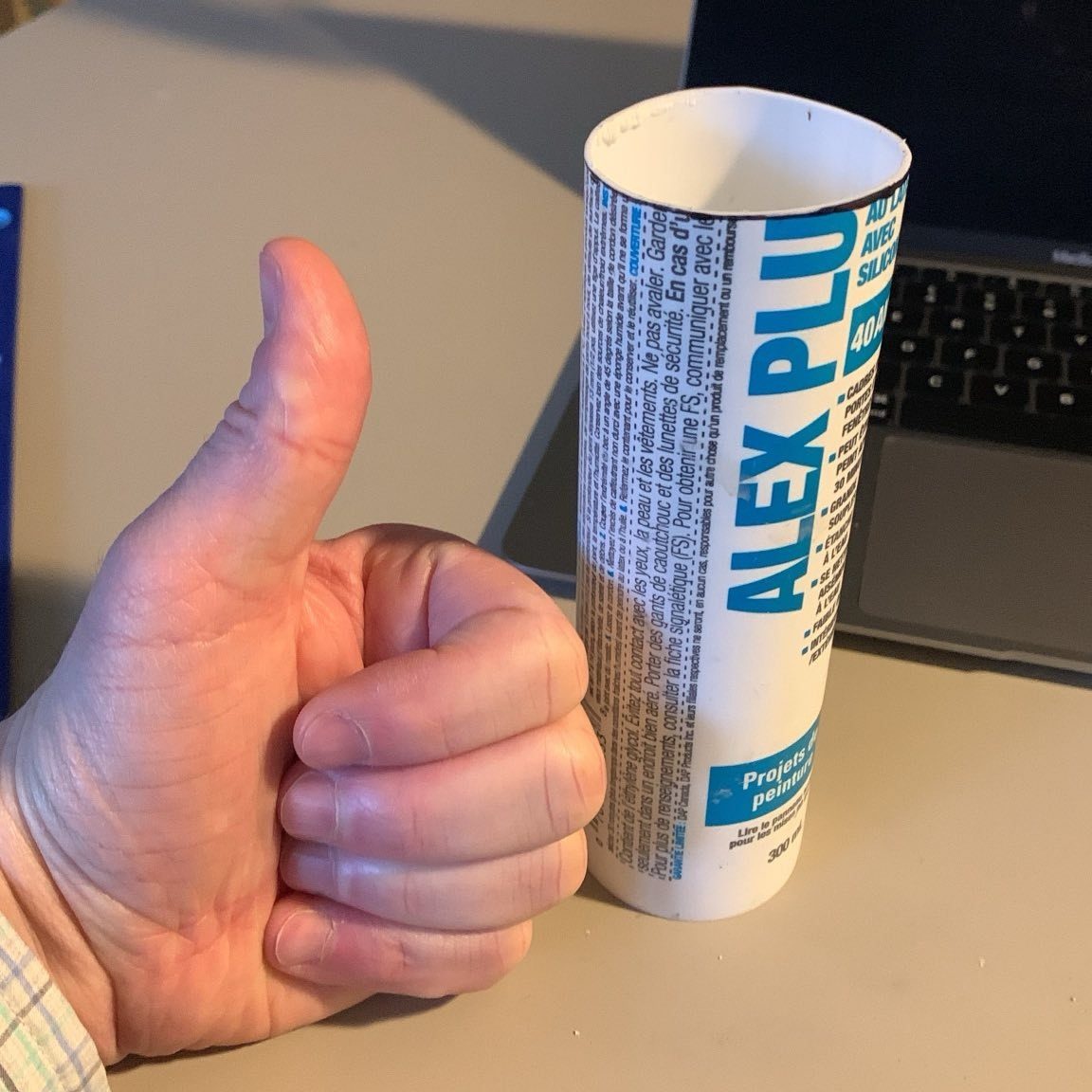
In fact, it was just that simple. I had this antenna together in about 30 minutes from start to finish. Turns out, too, that the hummingbird feeder off my dining room window puts the bottom of the choke just above ground level, and while not ideal, it got me started.

Drinking from the firehose would be an understatement, for sure. As I figured out my radio and how it worked (plus how it interfaced with my computer), I got a good sense of how this was going to go. It was time to go full Star Trek and hit first contact.
My daughter and I went out to Elk Lake park. I brought my gear and some rope with the intent of finding a spot where I could string this antenna up into a tree and maybe see some action. We found a spot, I (rather hilariously) discovered that my rope-throwing skills are woefully inadequate, but with some persistence I was able to get the top of the dipole about 8m up. Quick setup, quick SWR check (1.0!), and within a minute or so we’d tracked down K0BBC in South Dakota who was doing a POTA activation. My daughter was wide-eyed as we made the QSO. Given that she’s in first-year university and has kept my super-nerd tendencies at bay for so long, to see her interested in this activity was heartwarming indeed.
Over the next few days, I discovered the ins and outs of FT4 and FT8 using WSJT-X, and the thrill of chasing contacts that way. Still using that 10m dipole, I managed to high-score a QSO at 7,300km with JA7QVI, just above the noise floor. Tremendously exciting!
Inverted Vee for 10m
Not to be outdone, I did more reading and feverishly searched for new ways to find more efficient antennas. After seeing a video about the $10 inverted vee for 10m, and loving the MacGuyver-type tactics used to make one, back to Queale I went, with a pit stop at the dollar store for a cheap kitchen cutting board, and I got to work.
This one was made using the last of some old speaker wire I’ve been lugging around since I was a teenager. Between that, some cut-up cutting board, some connectors (SO-239, PL-239, BNC-M, ring terminals) and coax, in a matter of about half an hour I had another antenna cooked up.
Someone on Facebook recently quipped that ham radio is a “hobby of hobbies” and wow, do I ever feel seen.
My next activity was to figure out how to rig up a mast using what I had available at the house. I have a 16.5′ painter’s pole and a bunch of household twine kicking around, so I was able to secure the pole in a vertical position using some tent pegs from my bikepacking kit and my recently-acquired knowledge of how to tie guy lines.
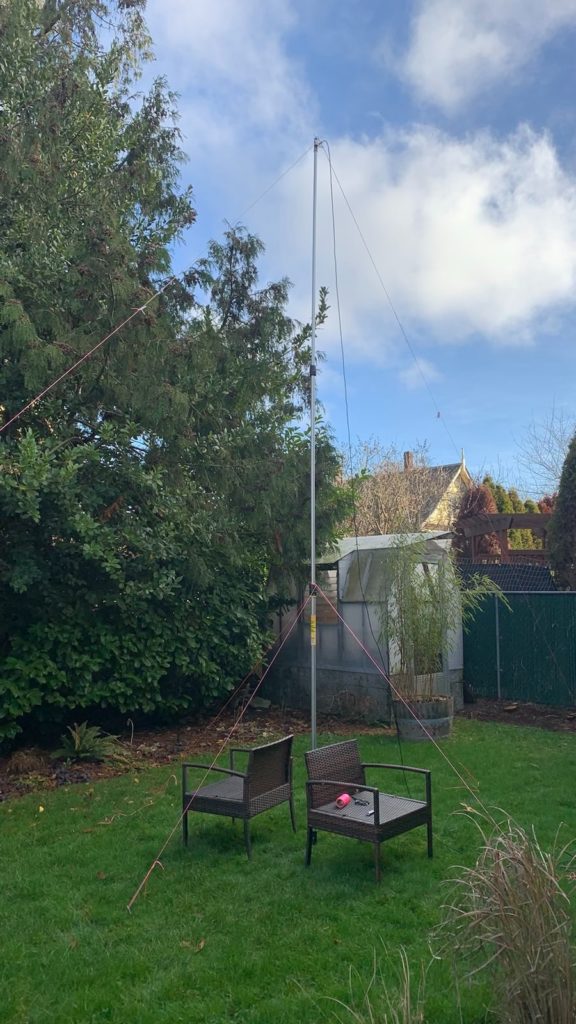
I zap-strapped the centre of the dipole to the plastic top of the pole, sent it up the maximum distance, and tied off the ends to about 45 degrees. Ran the coax into the house, spun the dial, 1.0 SWR again, and even better rx and tx than my vertical dipole, presumably because I wasn’t up against the faraday cage that is the stucco support in my house.
Next test for this antenna was a bit of field operation. I took a fellow ham from work (my stand-partner-in-crime, VA7SVT, Ross Macdonald) out to Elk Lake/Beaver Lake and we proceeded to do my first-ever POTA activation. We knocked out the requisite 10 contacts in a hurry, including a 33 report into Connecticut using 10W. I also demonstrated some FT8 prowess to Ross, as he hadn’t dug into any of that world before. I might have a new convert to on our hands. Ross and I spend a fair amount of time together on the road as touring musicians, so I see us doing more of this kind of activity in the future.
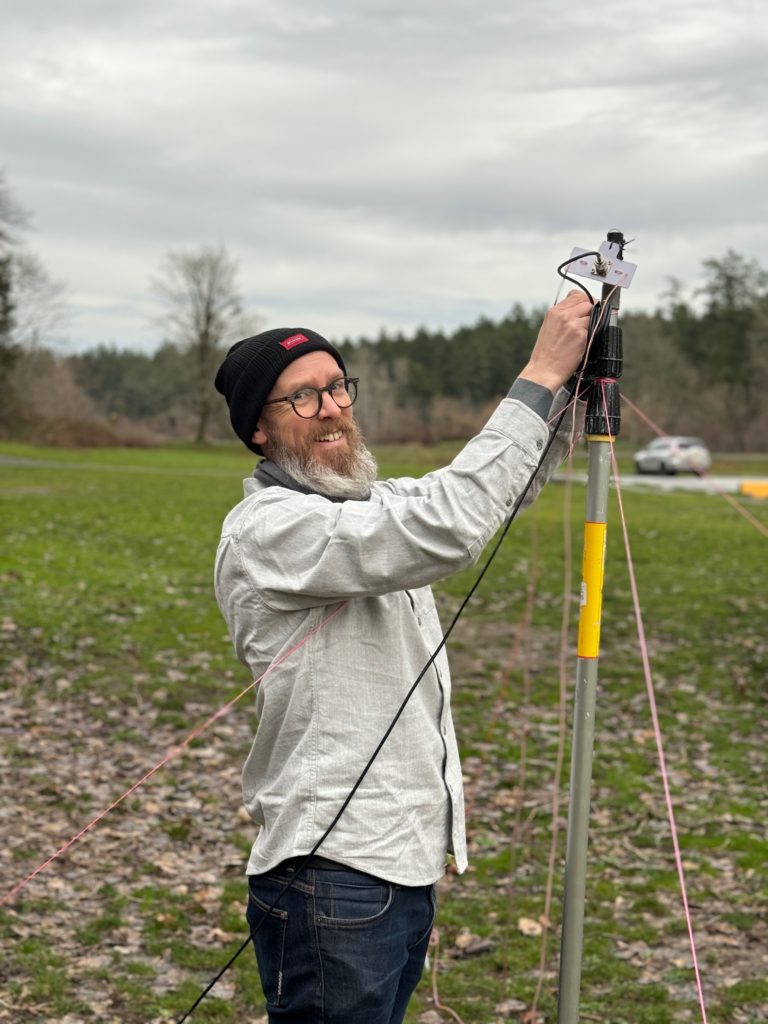
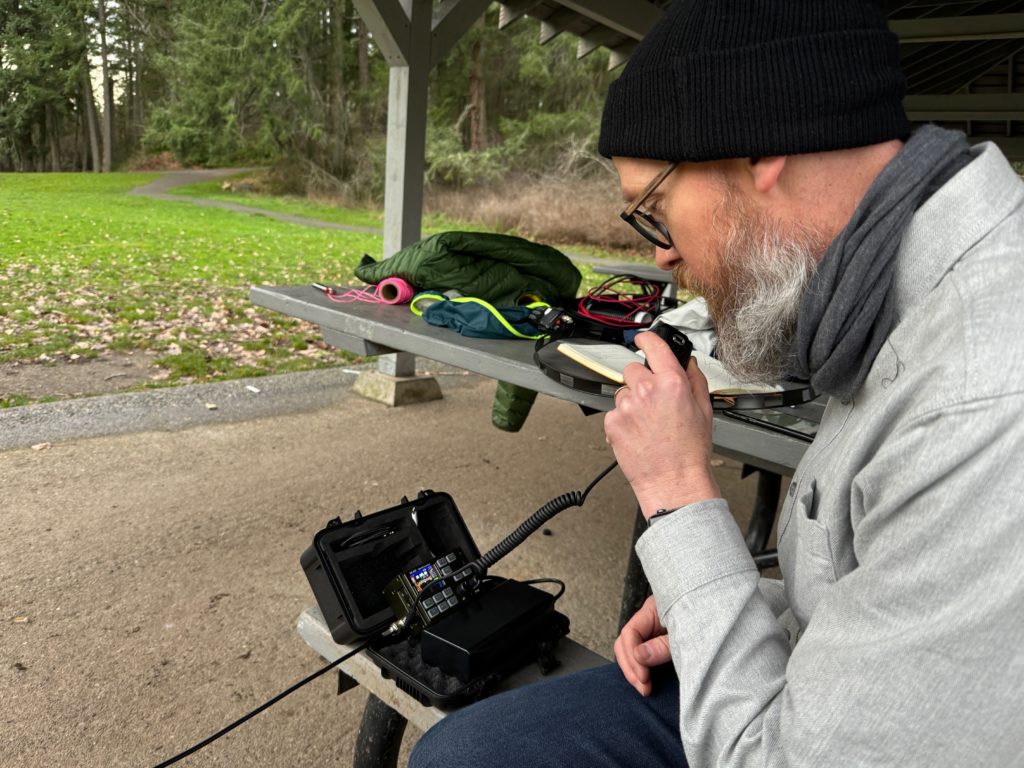
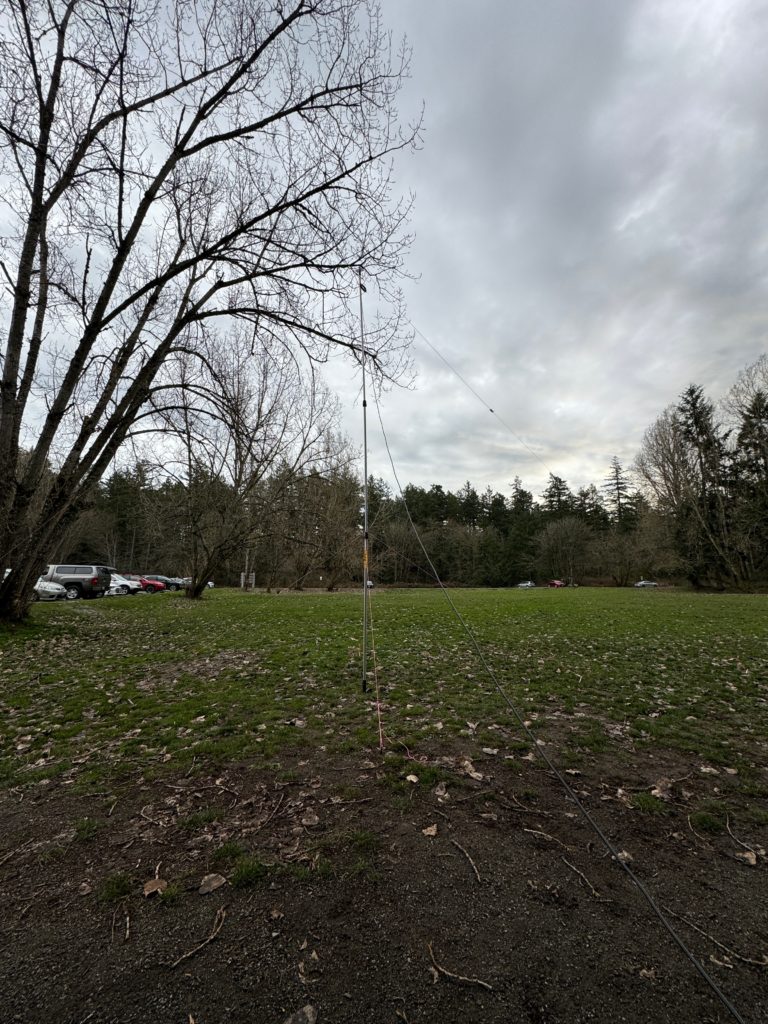
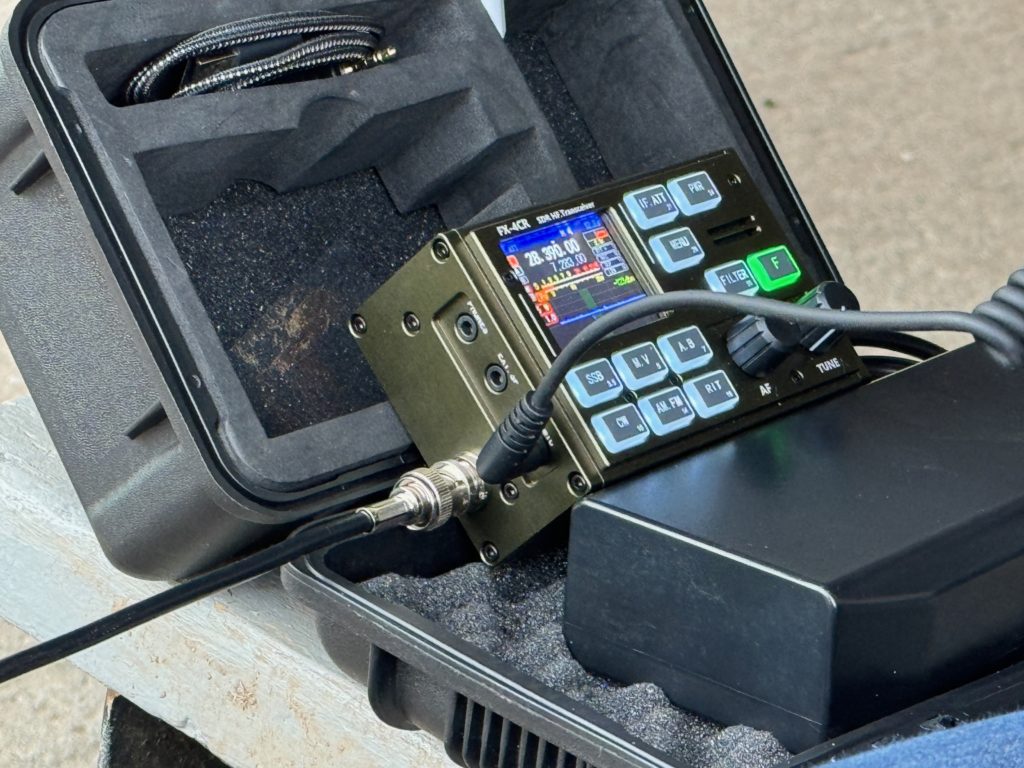
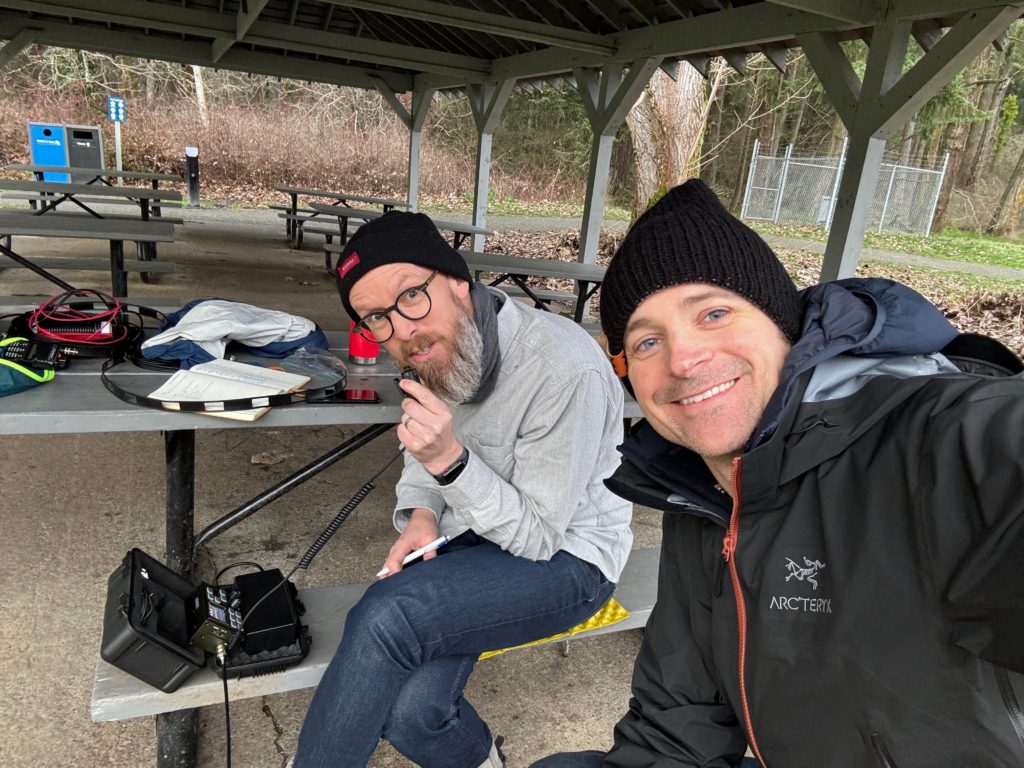
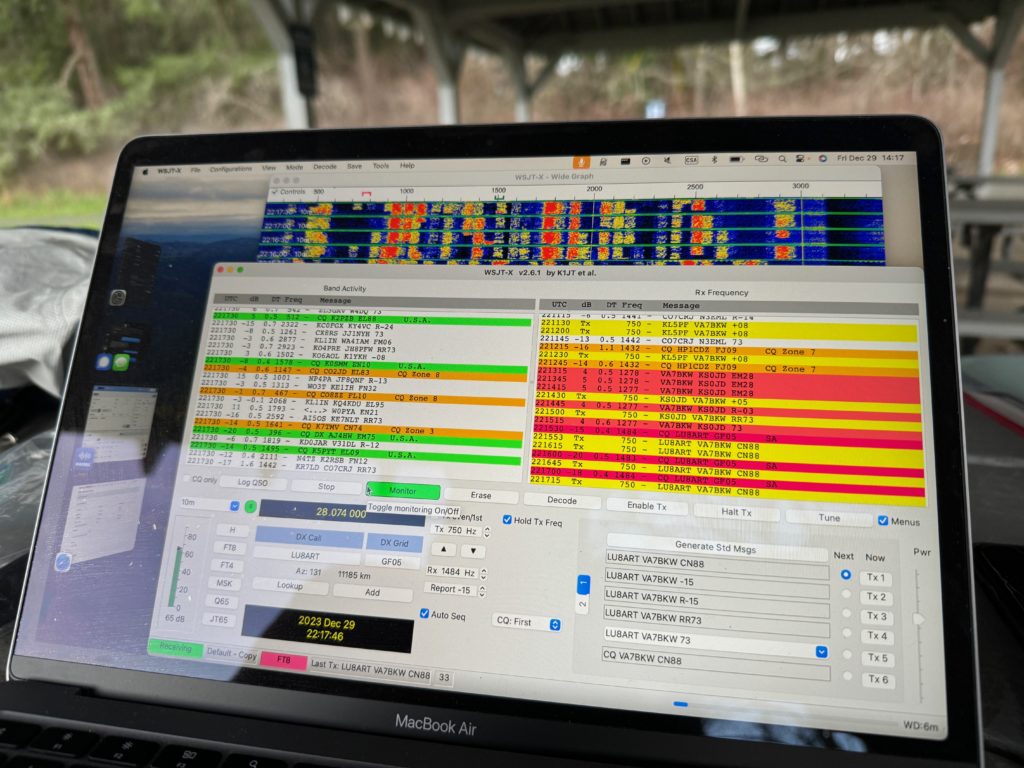
Inverted Vee for 20m
Not content to be relegated to 10m (and thus essentially daytime hours only), and with a brief and brutal introduction to the true definition of “maximum usable frequency“, I set out to re-create the magic for 20m. Same basic pattern as the 10m, but this time I played with the angle of the vee a little more. M0UKD has a good calculator that takes into account the angle of the vee, and off I went again.
With the 20m in hand, I set about trying a couple of configurations in the back yard. One was a repeat of the setup atop the pole – being that I selected a slightly lower angle (22.5 degrees) for my inverted vee on 20m, I had no difficulty tying off the ends to convenient points in my yard.
The other configuration I tried was a bit of a sloper, with less-than-excellent results. I centred my antenna off my hummingbird feeder, and brought the legs down into the yard. I’d need to do some more research on this, but I’d suspect that it had a bunch to do with the takeoff angle or somesuch.
Contacts have been far and wide with this setup. I’ve been able to hear stations all over North America, plus Japan, Russia, and South America. I’ve not been wanting to slash through the pileups to get my QSOs, although I did have a couple of nice contacts, one with a fellow in Alberta (VE6AO) and another in Ontario (VE3DPZ).
6m Slim Jim – They Can’t All Be Winners
I had previously made a 2m Slim Jim with ladder line courtesy of VE7HAR (thanks, Jim!). Said Slim Jim has enabled me to use my Yaesu FT-65R to be on the local repeaters, occasionally banging out 146.52 contacts, and for grins and giggles while on the road (sidebar: if you don’t know about the Puget Sound Repeater Group‘s 9 O’Clock Nets, get yourself on EchoLink and have a listen. It’s incredible).
Using the same technique as I had before, I did a little measuring courtesy of M0UKD’s handy calculator and went to it. Alas, this one didn’t quite work out as planned, or I have run into some MUF issues (or 6m has just been dead). I got some noise on the waterfall, but no signs of life anywhere. I’ll check my connections and give it another go (after this wretched wind storm is through) and see if it was just me.
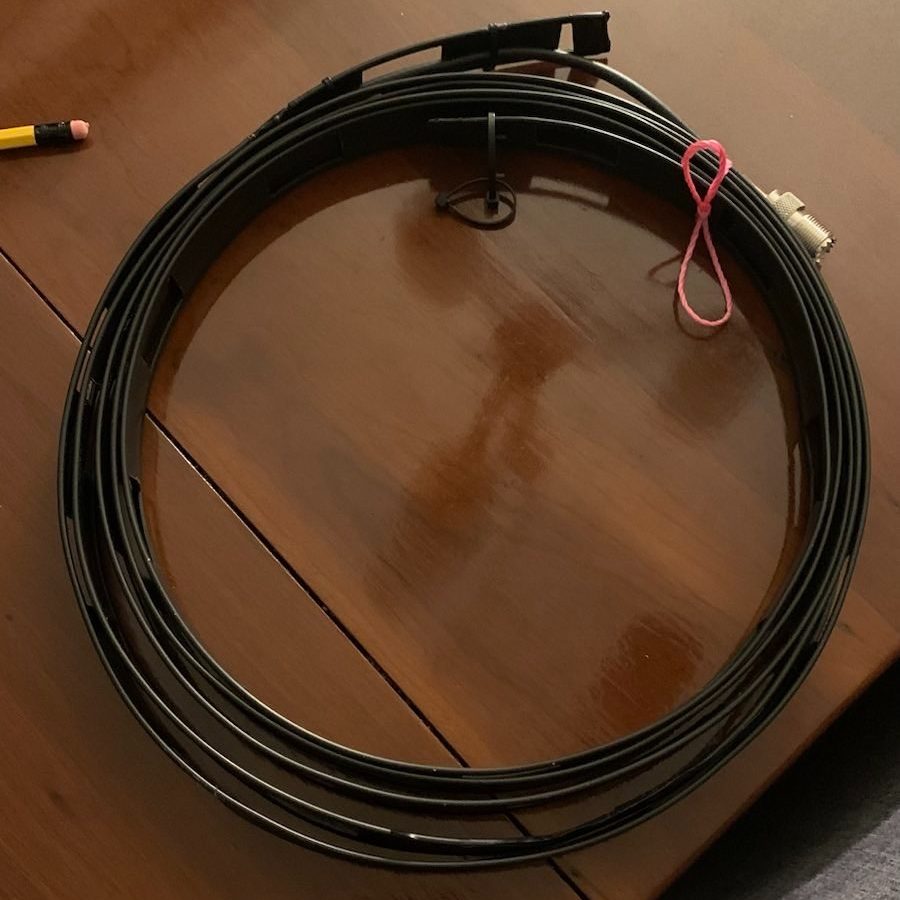
Bonus Homebrew – Cloudlog
I had started using HAMRS as my logger-of-choice, along with some paper and pen while out and about. With HAMRS, I like the interface, and especially the way it works for POTA activations, however, I kept looking about for what might be out there since one of the most notable gaps is in the lack of continuity between devices (iOS logs aren’t updated on desktop, and there is no import function to allow one to do this manually.
I came across Cloudlog via r/AmateurRadio on Reddit. It’s an open-source community-built web-based logging application. Given that I have web hosting set up with a company in California and a dangerously-low amount of knowledge of php, ssh, bash, cron, and various other old-school command-line and web server tools, I picked up another hobby along the way, that being the installer/maintainer of my very own web-based ham logging application.
Along with this came the rapid setup and integration of the various databases and logbooks on the internet (LoTW, eQSL, QRZ.com, etc). Cloudlog handles all of these (and a couple more) in terms of maintaining QSOs across the loggers of note automatically. Furthermore, it’s more than capable of handling ADIF imports (and exports), and does so automatically once properly configured, so one can continue to use a different logger (eg. HAMRS, the internal loggers in WSJT-X, JTDX, JS8Call, etc) in a situation where no internet is available and import with all the salient info directly at a later time.
Logging QSOs through Cloudlog is dead simple whether on my laptop or my phone. I haven’t played with the fast QSO method yet or any of the contesting modes, but everything else about this platform is solid.
What’s Next?
Well, I got a shiny new ATU-100, a 9:1 balun, and some connectors on the way. Next up for me will be a random long wire that hopefully will get me going on all the bands. I did the reading, found the page about random wire lengths, and I’ve settled on 42 feet (being a Douglas Adams fan). We’ll see what that gets me. My main goal is to continue to play the game of “Will It Antenna?” as well as seeing where my radio and I can find ourselves in the name of POTA, SOTA, IOTA, whateverotherOTA etc. I’m a fan.
Leave a Reply